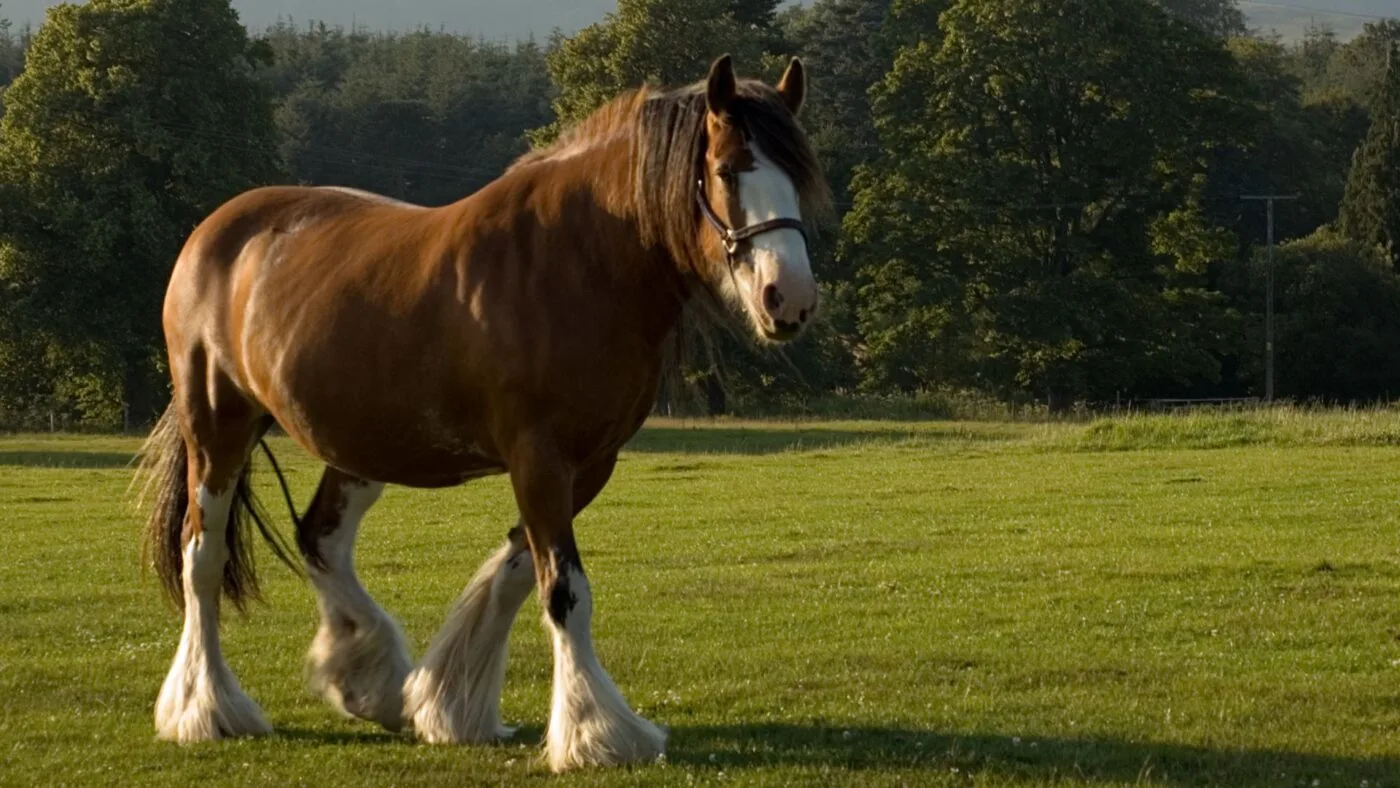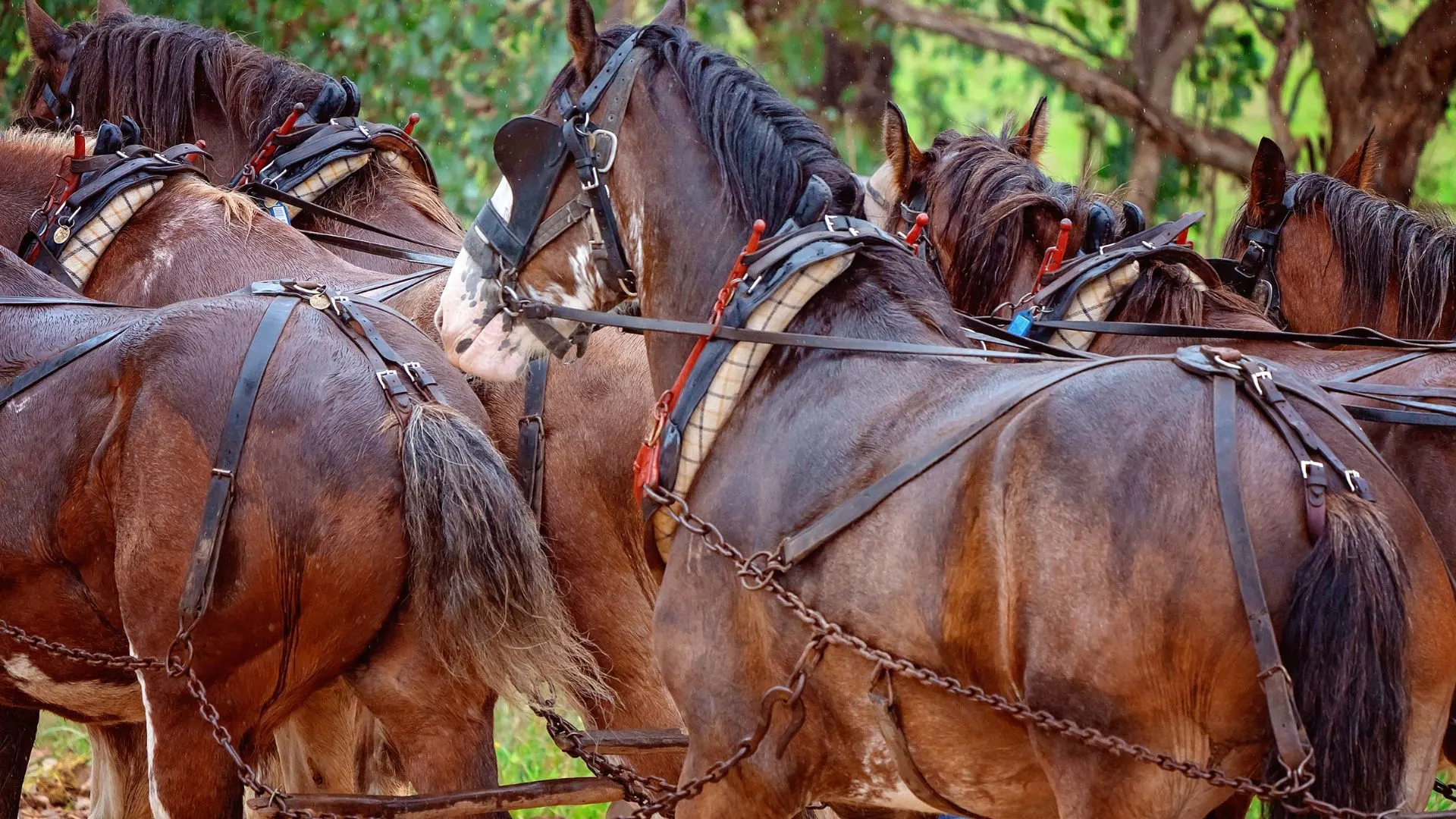Last updated: January 18, 2024
Have you ever wondered about the incredible strength of Clydesdales, the iconic draft horse breed known for its power and size? As a seasoned horse owner, I’ve witnessed firsthand the astonishing ability of Clydesdales to pull weights that far exceed their own.
These magnificent horses, hailing from the Clyde Valley in Scotland, are capable of pulling loads between 2,000 and 8,000 pounds, a feat unmatched by most other breeds. In this article, we’ll explore the fascinating world of Clydesdales, focusing on their extraordinary pulling strength.
From their historical significance in agriculture to their modern-day roles in parades and competitions, we’ll uncover the factors that contribute to their impressive capabilities. Join me in this journey to understand and appreciate the Clydesdale pulling strength, a true testament to the wonders of the equine world.

Clydesdales: A Legacy of Strength and Versatility
Tracing their roots back to 18th-century Scotland, Clydesdales have evolved from agricultural powerhouses to modern symbols of strength and versatility. This journey reflects their remarkable adaptability and enduring legacy.
Origin and Breeding
- Originated in Scotland’s Clyde Valley in the 18th century.
- Bred from local mares and Flemish stallions for strength.
Agricultural Beginnings
- Crucial in transforming Scottish agriculture.
- Excelled in plowing and heavy load transportation.
Evolution with Industrialization
- Transitioned from agriculture to industrial transport.
- Retained strength in more ceremonial and show roles.
Modern-Day Powerhouses
- Celebrated for both majestic appearance and power.
- Featured in competitive pulling events and parades.
From their origins in Scotland to their modern-day acclaim, Clydesdales have maintained their legacy as symbols of strength and versatility. Their evolution from agricultural laborers to celebrated show horses and competitors highlights their enduring power and majestic presence.

Anatomy and Physiology of Clydesdales: Keys to Their Strength
Discover the Clydesdale’s extraordinary strength through a closer look at their unique anatomy and physiology. From muscular build to resilient bone structure, each trait plays a crucial role in their impressive pulling power.
- Mighty Musculature:
- Well-developed muscles, especially in the hindquarters.
- Muscular shoulders for a broader range of motion.
- Solid Bone Structure:
- Larger, denser bones than lighter horse breeds.
- Robust skeletal framework supports heavy loads.
- Unique Hoof and Feathering:
- Larger, rounder hooves for stability and traction.
- Feathering around lower legs for protection.
- Lung Capacity and Stamina:
- Significant lung capacity for endurance.
- Vital for sustained strength in pulling tasks.
- Harmonious Combination:
- Muscle, bone, and hoof work together for resilience.
- Enables remarkable feats of strength.
The Clydesdale’s strength is a harmonious blend of muscular power, solid bone structure, unique hoof design, and exceptional lung capacity. Each element synergistically contributes to their legendary pulling ability, showcasing the Clydesdale as an ideal of equine strength and endurance.

Clydesdale Driven by Billy McCrorie, CC BY-SA 2.0
Clydesdale’s Pulling Prowess: Records and Modern-Day Strength
The Clydesdale horse has a storied history of pulling prowess. From individual feats to team efforts, these horses have set benchmarks in pulling strength, playing a crucial role in both historical and modern settings.
- Individual Clydesdale Pulling Strength:
- Can pull 2,000 pounds at a walk, setting a significant benchmark for draft breeds.
- Historically vital for agricultural and transportation tasks in the pre-industrial era.
- Pairing Capabilities:
- A pair of Clydesdales can impressively pull approximately 18,000 pounds.
- Showcased in parades, demonstrating both strength and elegance.
- Comparative Strength in Competitions:
- World record in draft horse competitions: 22,000 pounds, held by Belgian horses.
- Clydesdales maintain a strong presence in these events, known for their combination of power and endurance.
The Clydesdale’s pulling capabilities, whether individually or in pairs, demonstrate a blend of power and elegance. Their enduring presence in competitive pulling events and their historical significance underscore their status as one of the most powerful draft breeds.
Training and Conditioning Clydesdales for Peak Performance
Training a Clydesdale for pulling tasks is a meticulous process that begins early in the horse’s life. It involves a combination of strength training, endurance exercises, and skill development. The training regime typically includes:
- Gradual Weight Pulling: Starting with light loads, trainers gradually increase the weight as the Clydesdale builds strength and confidence.
- Endurance Building: Regular exercise routines, including walking and trotting, help develop the horse’s stamina, which is crucial for sustained pulling.
- Skill Training: Horses are trained to respond to commands and work in harmony with a team, which is essential for coordinated efforts in pulling competitions.
Conditioning for Strength and Health
Conditioning Clydesdales goes beyond physical training. It encompasses:
- Diet and Nutrition: A balanced diet rich in protein and fiber ensures the Clydesdales have the energy and muscle-building nutrients they need.
- Regular Health Check-ups: Veterinary care, including regular check-ups and hoof care, is vital to maintain their health and pulling capabilities.
- Mental Well-being: Mental stimulation and rest periods are crucial for keeping Clydesdales alert and responsive.
Insights from Experts
Trainers and Clydesdale owners emphasize the importance of patience and consistency in training. Key insights include:
- Customized Training Plans: Each Clydesdale is unique, and training plans are tailored to individual needs and capabilities.
- Building Trust: Establishing a bond and trust between the horse and the trainer is fundamental for successful training.
- Monitoring Progress: Regular assessments help in adjusting training methods and ensuring the horse is developing the required strength without strain.
Academic Study
A study published in BMC Veterinary Research highlights the physiological impact of heavy horse pulling competitions. It reveals that while horses undergo rapid weight changes for competitions, they generally have sufficient time to rehydrate and recover, ensuring their well-being. The study underscores the resilience of draft horses like Clydesdales in high-intensity, short-duration pulling tasks.
Citation: Reference: Lange, K., et al. (2017). High intensity, short duration pulling in heavy horses: physiological effects of competition and rapid weight change. BMC Veterinary Research, 13, 324. PubMed Central.
Preparing for Competitions
For Clydesdales participating in pulling competitions, preparation includes:
- Simulation of Competition Conditions: Training under conditions similar to competition environments helps acclimate the horses.
- Mental Preparation: Getting the Clydesdales comfortable with crowds and noises they will encounter in competitions.
- Team Coordination: For pairs or teams, ensuring the horses work well together is as important as their individual strength.

Clydesdales Today: Harnessing Strength in Modern Roles
In today’s world, Clydesdales continue to showcase their impressive strength, transitioning from traditional farming to roles in sustainable logging, entertainment, and competitive events.
Farming: A Tradition Continues
While modern machinery has largely replaced horses in farming, Clydesdales still find their place in certain agricultural settings. Their strength is particularly valued in:
- Boutique and Organic Farming: Where the use of heavy machinery is limited, Clydesdales are used for plowing and other farm tasks, offering an eco-friendly alternative.
- Vineyards and Orchards: In spaces where machinery can’t maneuver or might damage the terrain, Clydesdales are the perfect fit for hauling and plowing.
Logging: Strength Meets Sustainability
In sustainable forestry practices, Clydesdales are making a significant impact. Their roles include:
- Selective Logging: Their ability to navigate through dense forests with minimal environmental impact makes them ideal for selective logging operations.
- Transporting Logs: Clydesdales can haul logs out of forests with less soil compaction and ecosystem disruption compared to heavy machinery.
Entertainment and Ceremonial Roles
Clydesdales are stars in various entertainment and ceremonial settings:
- Parades and Shows: Their majestic appearance and calm demeanor make them crowd favorites in parades, shows, and public events.
- Film and Television: Clydesdales often feature in movies and commercials, capturing the audience’s imagination with their grandeur.
Competitive Pulling: Showcasing Raw Power
Clydesdales continue to demonstrate their pulling power in:
- Draft Horse Pulling Competitions: These events are a testament to their strength, where they pull heavy weights over short distances.
- Team Competitions: Clydesdales showcases strength, coordination, and training in pairs or teams.
Therapeutic and Recreational Riding
Beyond their strength, Clydesdales’ gentle nature has made them suitable for:
- Therapeutic Riding Programs: Their steady gait and temperament make them excellent choices for therapy and rehabilitation programs.
- Leisure Riding: Despite their size, Clydesdales are gentle giants, making them suitable for leisure riding experiences.
Below is a Youtube video of a horse pulling contest.
The World of Draft Horse Pulling Competitions
Here is the graph diagram illustrating the comparative pulling strength of a single Clydesdale horse against other breeds like Belgian horses, Percherons, Shires, and an average horse.
- Competition Mechanics:
- Competitions start with a predetermined load, expected to be within most teams’ capabilities.
- Teams are eliminated if they fail to pull the load the required distance, with drivers having the option to withdraw if necessary.
- Successful teams progress to pull heavier weights, aiming for a ‘full pull’ as defined by the competition rules.
- Measuring Pulling Power:
- Horses pull either a boat (a flat-bottomed sled) or a dynamometer, which offers consistent resistance and measures strength accurately.
- The dynamometer, a staple in pulling events, provides a fair and uniform challenge to all teams.
- Competition Rules and Ethics:
- Competitions are divided by weight class to ensure fairness.
- Strict rules are in place to prevent animal cruelty, with a focus on ethical treatment and fair competition.
- Concerns about unethical practices like drugging or overworking horses are addressed, emphasizing the importance of humane treatment in these events.
- Clydesdales’ Role and Performance:
- Clydesdales, along with other draft breeds like Belgians and Percherons, are common in these competitions.
- Their training and breeding for pulling are highlighted, showcasing their natural ability in these contests.
Navigating the Ethics of Horse Pulling Competitions
Horse pulling competitions, while showcasing the remarkable strength of Clydesdales, raise important ethical considerations:
- Animal Welfare: The primary concern is the well-being of the horses during these events. Questions arise about the potential strain and stress on the animals, especially when pulling maximum weights.
- Public Perception: How these events are perceived by the public and animal welfare advocates plays a significant role in their ethical evaluation.
Ensuring Health and Well-being
Organizers and participants of horse pulling competitions take several measures to ensure the safety and health of the horses:
- Veterinary Oversight: Competitions often have veterinarians on-site to monitor the health of the horses and intervene if any signs of distress are observed.
- Weight Limits and Rest Periods: Setting limits on the weights pulled and providing adequate rest periods between pulls help prevent overexertion.
- Training and Conditioning: Proper training and conditioning prior to events ensure that horses are physically prepared for the tasks.
Regulations and Standards
To address ethical concerns, horse pulling events are governed by regulations:
- Rules and Guidelines: Competitions have strict rules regarding weight classes, pulling techniques, and equipment to ensure fairness and prevent injury.
- Inspections and Compliance: Horses are inspected for signs of ill-treatment, and participants must comply with animal welfare standards.
Promoting Positive Practices
Participants and organizers are increasingly focusing on promoting the positive aspects of these events:
- Education and Awareness: Educating the public about the training, care, and natural abilities of Clydesdales can help alleviate concerns.
- Highlighting the Bond: Showcasing the strong bond between the horses and their handlers can help demonstrate the care and respect given to these animals.

FAQs about Clydesdale Horses
Are Clydesdales bigger than Belgians?
Belgians are generally larger and heavier than Clydesdales, known for their massive size among draft breeds.
Can you ride a Clydesdale?
Yes, Clydesdales can be ridden. Despite their size, they are known for their gentle temperament, making them suitable for riding.
Is the Clydesdale one of the largest draft breeds?
Clydesdales are one of the largest horse breeds, renowned for their height and strength, but they are typically not the strongest when compared to breeds like the Belgian.
How much weight can a Clydesdale pull?
Clydesdale can pull between 2,000 and 8,000 pounds, depending on various factors like conditioning and training.
What are Clydesdales used for today?
Today, Clydesdales are used in parades, competitive pulling events, and even in therapeutic and leisure riding programs.
Conclusion: Clydesdale Pulling Strength
The Clydesdale breed stands as a remarkable testament to both the power and grace of draft horses. Their extraordinary pulling strength, deeply rooted in their history and evolution, continues to be showcased in various modern settings.
From sustainable farming practices and selective logging to their captivating presence in parades and pulling competitions, Clydesdales demonstrates a versatility that goes beyond mere brute strength.
Key Points to Remember:
- Incredible Strength: Clydesdales can pull significant weights, with pairs capable of hauling up to 18,000 pounds.
- Versatile Roles: Beyond strength, they adapt to roles in farming, logging, entertainment, and therapeutic riding.
- Ethical Considerations: The well-being of Clydesdales in pulling competitions is paramount, with ongoing efforts to ensure their health and humane treatment.
As we reflect on the majestic nature of Clydesdales, it’s not just their physical capabilities that captivate us but also their gentle temperament and the deep bond they share with their handlers.
Their enduring legacy is not only etched in the fields and forests they once toiled but also in the hearts of those who witness their grace and power. The Clydesdale breed, with its unique blend of strength, elegance, and resilience, continues to be a symbol of enduring beauty and capability in the equine world.
Join the Conversation: Share Your Clydesdale Stories
The world of Clydesdales is as diverse and rich as the stories of those who have interacted with these magnificent creatures. Whether you’re a Clydesdale owner, a horse enthusiast, or someone who’s simply been touched by the presence of these gentle giants, your experiences and stories are invaluable.
- We Want to Hear from You: Have you had a memorable experience with a Clydesdale? Perhaps a moment in a parade, a visit to a farm, or even a personal journey with owning or training one of these magnificent horses?
- Share Your Clydesdale Photos: Do you have photos of Clydesdales that capture their strength, beauty, or unique personality? We’d love to see them! Share your best shots and tell us the story behind them.
- Questions and Curiosities: Are you curious about Clydesdales? Do you have questions about their care, training, or capabilities? Feel free to ask, and let’s learn together from the community’s wealth of knowledge.
Call-to-Action
- Comment Below: Share your stories, experiences, and photos in the comments section. Let’s create a tapestry of tales that celebrate the Clydesdale breed.
- Join Our Community: Follow us on [Social Media Handles] for more engaging content about Clydesdales and other horse breeds. Be a part of a community that shares your passion for these extraordinary animals.
Connect with Me
- Email: [email protected]
- Social Media: Follow me on Facebook for updates, tips, and insights into the world of horses.
- Website: Visit my website horseracingsense.com, for more articles, resources, and information about horses.
- YouTube
Related Articles:
- Are Belgian horses bigger than Clydesdales
- The Clydesdale horse breed, are they too big to ride?
- 12 Horse Coat Colors: Patterns, Genetics, and Pictures
Meet Miles Henry
An avid equestrian and seasoned racehorse owner, Miles Henry brings his extensive experience to the equine world, proudly associating with the AQHA, The Jockey Club, and various other equine organizations. Beyond the racetrack, Miles is an accomplished author, having published various books about horses, and is a recognized authority in the field, with his work cited in multiple publications.
🔗 Connect with Miles:
Twitter
Facebook
YouTube: Check out race highlights, horse care tips, and more!

